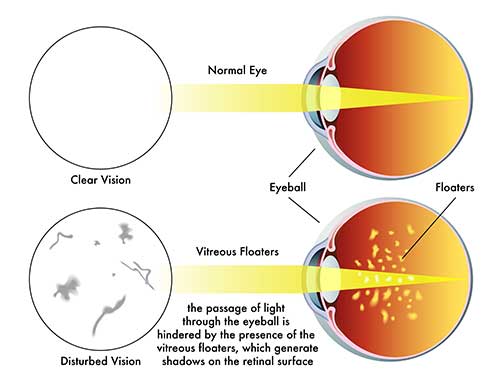Flashes and Floaters
Floaters look like small specks, dots, circles, lines or cobwebs in your field of vision. While they appear to be in front of your eye, they are actually floating in the back compartment of the eye in a gel substance known as the vitreous gel. Kind of like a snow globe, the floaters are tiny clumps of gel or cells inside the vitreous. The floaters cast shadows on the retina which we interpret as objects in our field of vision. As we age, our vitreous starts to thicken or shrink. Sometimes clumps or strands form in the vitreous as the aging process takes place. If the vitreous pulls away from the back of the eye, it is called “posterior vitreous detachment” or “PVD”. Floaters usually occur when this happens. They are often not serious and tend to fade or go away over time. A portion of PVDs can be associated with retinal tears which can be a precursor of retinal detachments. You should be examined by an ophthalmologist if you begin to experience floaters that were not previously in your field of vision.
 Floaters are more likely to occur if you:
Floaters are more likely to occur if you:
- Are nearsighted (you need glasses to see far away)
- Have had surgery for cataracts
- Have had inflammation or swelling inside of the eye.
Flashes can look like camera flashes or lightning streaks in your field of vision. An individual may see flashes off and on for weeks or even months. Flashes happen when the vitreous rubs or pulls on your retina. As people age, it is common to see flashes occasionally. Similar to new floaters, if you experience new flashing symptoms you should be examined by an ophthalmologist as this can be associated with retinal breaks or tears.
Most floaters and flashes are not serious, however , they can be quite a nuisance. At Advanced Eye Institute, it is our opinion that there is no completely safe treatment to remove floaters surgically, and it is best to leave them alone. They tend to go away with time.
There are times when flashes and floaters can be signs of a serious condition. If you’re experiencing many new floaters, or you are having frequent flashes, you should contact your Ophthalmologist right away. If a retinal tear or break is found you may need laser treatment to weld down the retina around the tear so it does not cause a retinal detachment. This is known as “laser retinopexy”. Retinal detachments can also be associated with flashes and new floaters followed by the feeling like there is a dark or blurry “curtain coming down” over part or all of your visual field. You should see your ophthalmologist as soon as possible if these symptoms occur.
Experience You Can See
Thibodaux : 985-446-0506 | Houma : 985-879-2393
